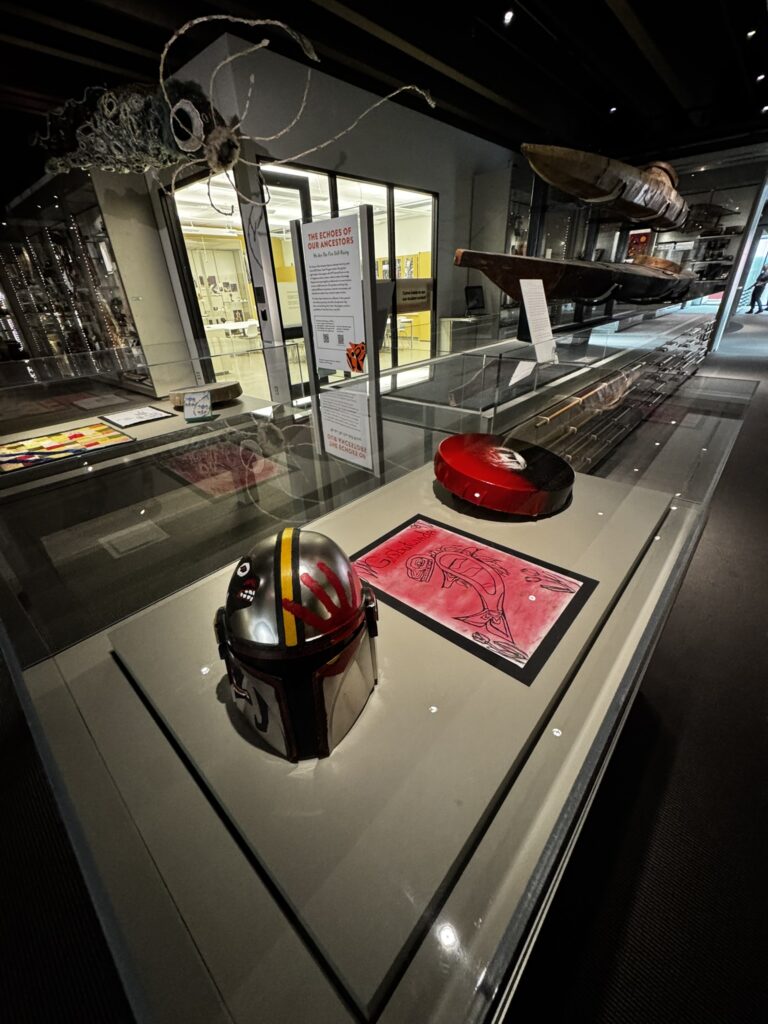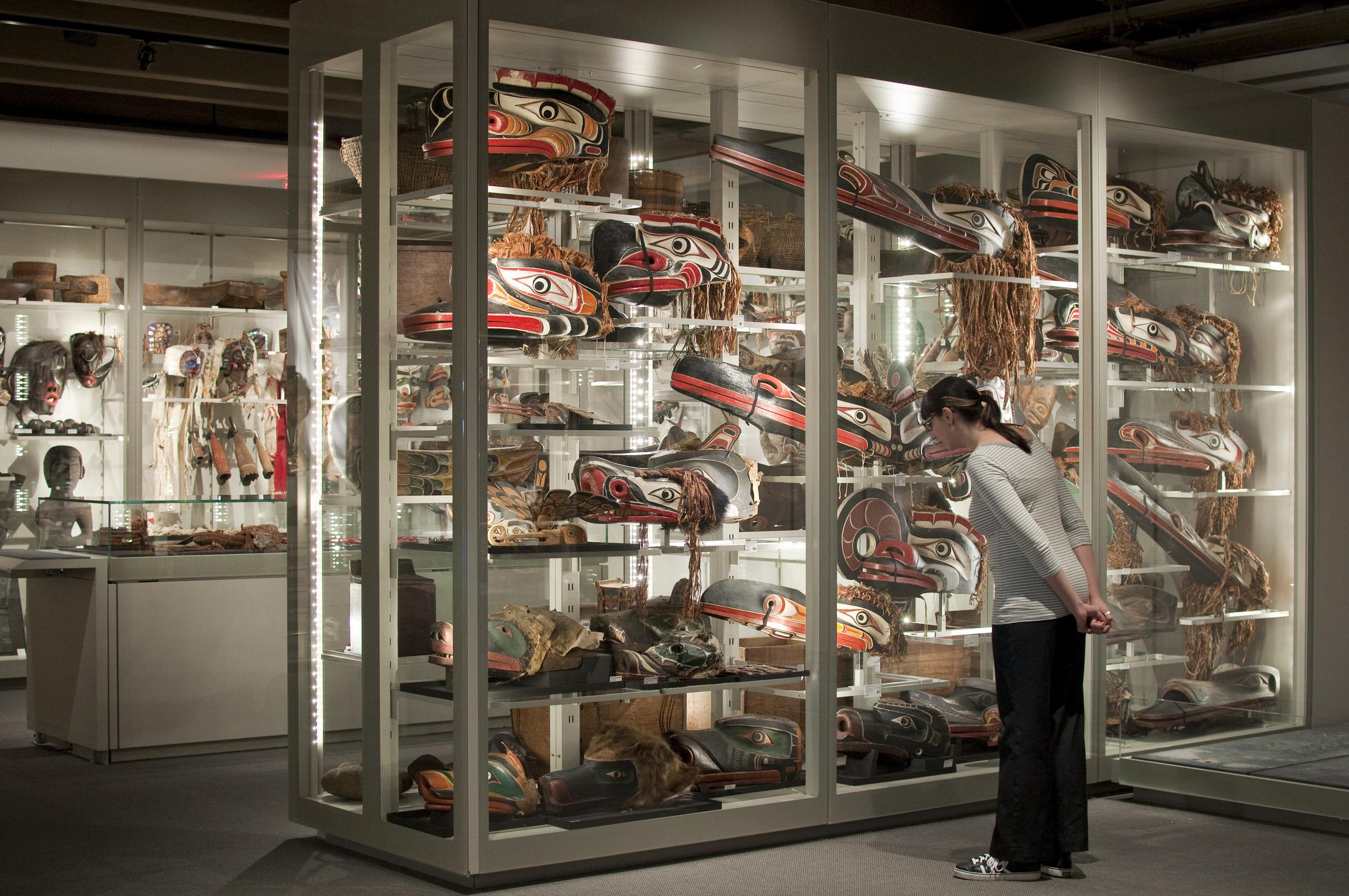
This summer the participants of the Native Youth Program at MOA finished off their program with a pop-up exhibition, curated by NYP Manager, Jacqueline Morrisseau-Addison (Saulteaux). The Echoes of Our Ancestors: We Are the Fire Still Rising featured selected works by youth in the 2025 Native Youth Program cohort. During their eight weeks in the program, the NYP learned from a wide array of Indigenous artists, curators, cultural workers, Knowledge Keepers and museum/gallery professionals at various locations across so-called Vancouver.
During these workshops they explored different art practices, materials and processes, and selected one creation they wanted to explore further. For them, these creations reflect their personal and collective journeys, the skills and exploration they have nurtured during their time in the program, as well as possibilities of what their future may hold.
Artist Statements

Isobel Snow (Nuxalk)
Cotton fabric, thread, ribbon
I represented the sun rising over land using the colours of my fabric. So, I used a lot of pinks, orange, yellow and red fabrics as well as a little bit of green to represent the land and a blue ribbon to act as the rivers in Bella Coola which is where my people are from. I represented a sunrise because of what my ancestral name is and how I thought of it as a child. My name, Ximulumclyc, means ‘light is upon the land’ so I always equated it to a sunrise. I felt a pull to sew a blanket as a sort of thank-you to my grandmother who has sewed hundreds of quilts and other projects for me.
Photo courtesy of Isobel Snow
Jordan Chippeway (Nuxalk, Heiltsuk)
River
Elk hide, wood, acrylic paint

I made this drum and on it, I painted my ancestral name – Nuqtaax – and the meaning of it. The meaning of my name is winding river. My name is very important to me because no one else has it. Why did I make this drum? Well because I’ve always loved making drums and this is one of the best ones I’ve made. This was my first time painting on a drum. Seeing all the painted drums in my home inspired me to paint this one.
In these photos I’m wearing my button blanket, cedar hat, apron and drum next to a river in Katzie homelands. When I was drumming next to the river, it felt really powerful.

Photos courtesy of Jordan Chippeway. Photographed on the lands of Katzie First Nation, Pitt Meadows

Lakeisha Wanderingspirit (Cree, Gwitchin, South Sudanese)
Paper, graphite
The uncontrolled life when I close my eyes at night – it holds secrets.
Being disturbed by the things that haunt me while I travel in reality, not understanding my own discomfort – it shows itself.
Needing relief from the past, I have run around for answers to stop these odd dreams but it was always right in front of me.
I realize it’s practices, the culture.
Now I remember.
Photo courtesy of Lakeisha Wanderingspirit

Fara Campbell-Kamangirira (Musqueam, Zimbabwean)
Seed beads, thread, felt
Across many Indigenous cultures, beadwork has been a form of cultural representation, artistic expression, and storytelling. The story of my beadwork starts with my late aunty, Iris. She passed away when I was around 6 or 7. She has been in my thoughts quite a bit recently, so in order to feel closer to her I decided to make a pair of beaded iris earrings and a matching lanyard.
Photo courtesy of Fara Campbell-Kamangirira

Serena Ridley (Kitkatla/Tsimshian)
Gisbutwada (2025)
Paper, chalk
I had many other ideas but couldn’t decide and I chose to stay simple and do a drawing based off my crest which is a killer-whale. In my cultural language, you call it gisbutwada. But I wanted to do something with my crest the whole time though. My inspiration was based off this one workshop I did with the NYP.
I made this drawing with bright and dark colours and it means a lot to me. The killer-whale, red and black is what we use in our cultural attire and such and the killer-whale is one of the main four crests we have in our culture. The way I drew the killer-whale is a replica of my grandfather drawing he helped me with not long ago. And I look up to him and my grandmother a lot and it makes me happy that I get to do this piece and show it and draw it.
Photo courtesy of Serena Ridley
Donnell Auger (Kwakwa̱ka̱ʼwakw)
Legendary Monkey Mandalorian Helmet
Black series Mandalorian helmet, acrylic paint

My name is Donnell Evan Auger and my traditional name is Hit-Tam-As, which in Kwak waka’wakw translates to ‘Fixing Things That Are Wrong’. I am 18 years old Gwasala Nawkwaxda and Namgis nation and this helmet is my personal art piece.
A long time ago in a galaxy far, far away…. (East Van, mid 2010s lol) back when I was just a boy, my two brothers, my late father and I used to watch movies and other media religiously together and one of my favourite things to watch as a family was Star Wars – ranging from the prequels, original trilogy, and spin-offs such as the clone wars and Star Wars rebels.
The monkey design on my helmet was my father’s that he painted around the same age as I am now – a native youth. I decided to revive and resurrect his original art piece he created a lifetime ago because like my dad and uncle Darcy, my favourite animal is the monkey. I enjoyed creating this piece and I felt as if I am now starting a path of self-redemption.

“I’m just a simple man making his way through the galaxy. Like my father before me.”
The red hand imprint – a symbol for the powerful Indigenous movement, No More Stolen Sisters – on the opposite side of my late father’s monkey is in honour of the strong warrior women like my grandmothers, aunts, sisters, managers/teachers, and my dear late mother. They all helped raise me to be the man I am today and commemorate those who are and unfortunately aren’t still here helping me as much as they can every day.
Thank you for reading! – Donnell
Photos courtesy of Donnell Auger
Trenton Milette (Mowhawk/Blackfoot)
Voices
Audio work
I was inspired to make this song as I imagined what it would be like to not have ADHD. As I myself have ADHD my brain is constantly thinking up new things every few seconds and with this it becomes harder and harder to focus on a singular task. The multiple voices all shouting at once demonstrates to the listener what it is like to have ADHD.
The second verse is where a change occurs as it goes from multiple things at once to just a hipification on a singular thing showing the other side of that same coin to those who listen.
This is all to demonstrate the attention deification and hyper fixation all in one simple song where there is two sides and very little grey area between.
Tristan Point (Musqueam/Filipino)
Elk hide, wood, acrylic paint

This drum is both a work of craft and a way to honour my dad. I began by preparing the hide, cleaning and shaping it so it could carry sound, then weaving it tightly with string to create the voice of the instrument. On a separate sheet of paper I carved a buck, mountain, and trees each a symbol of my father and the Ashnola mountains where he once took me hunting when I was little and where he got married. In doing so, I honour not only his memory as my father but also his legacy at the Museum of Anthropology and the work he dedicated a good portion of his life to. For the painting, I chose spray paint for its ability to create soft, layered textures. I first laid down a white base, then used a stencil to apply black and red, letting the colours fade into one another without harsh separation. This blending reflects both the colour of my hair and my own mixed heritage, as someone from the Musqueam Nation and the Philippines. Through this drum, I bring together sound, land, and identity—holding the voices of my family, their traditions, and my fathers legacy in one form.
Tristan’s drum on display at MOA. Photo by Kristi Fuoco

The Native Youth Program is a summer program at the Museum of Anthropology for urban Indigenous Youth ages 15 to 18. To learn more about this program and processes in creating their artworks, listen to our podcast on Spotify.
Follow MOA NYP on Instagram.














